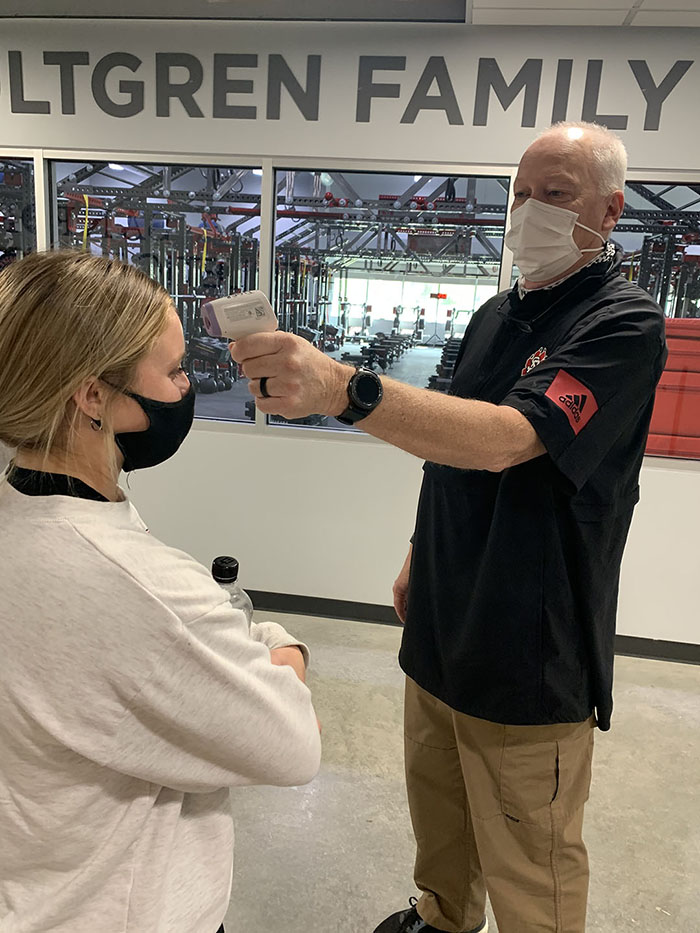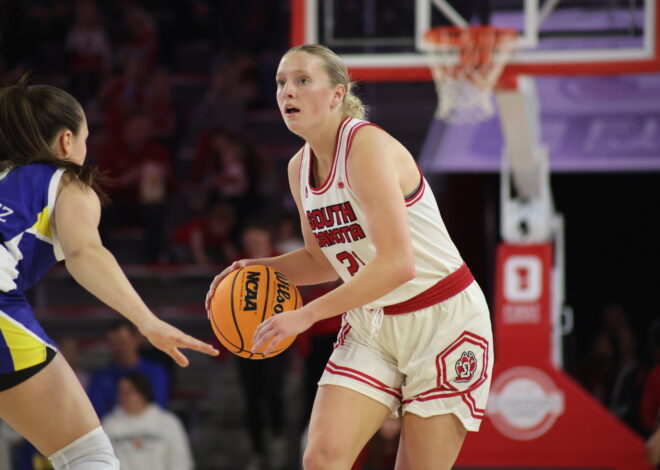
Athletic trainers continue to serve athletes
Athletic trainers at USD are still finding ways to schedule training sessions and work on athlete rehabilitation while conforming to new COVID-19 safety guidelines.
Kylea Sheley, the athletic trainer for women’s basketball and softball, said every athlete is screened for COVID-19 symptoms before they train via a questionnaire and temperature check. Athletes are also required to contact their trainer if they feel sick so they can be quarantined and so contact-tracing can occur.
“The amount of communication we have with our student-athletes, coaches and staff within this building has basically tripled,” Sheley said. “We’re getting calls at 5 a.m. in the morning until oftentimes pretty late at night, which isn’t uncommon for us, it’s just a lot more frequent.”
The biggest issue to tackle in the workout room, Sheley said, is making sure it is safe for both training and rehab. In the summer, teams could spread out and train on outside practice fields, but now, athletes using the training room must wear masks, use hand sanitizer and social distance.
To make workouts easier, Sheley said lots of athletes now carry equipment in their backpacks, and workout cards — instructions for athlete’s exercises — have become digital, which prevents athletes from having to handle physical cards.
“(If athletes) don’t have to go grab a card from a coach, it actually makes the delivery of some of that material a lot easier and touch-free for coaches,” Sheley said.
Colby Keegan, the athletic trainer for football, said scheduling time to train large groups of athletes is difficult not only because of the new safety guidelines, but because of the athlete’s own class schedules.
“We’re working around limited people in the weight room, limited times to practice and limited people we can have in the training rooms,” Keegan said. “We have a pretty big training room, but you don’t want to get it too packed at the same time.”
Assistant Athletic Director for Sports Medicine Bruce Fischbach said when it comes to rehabilitation and physical therapy for athletes, both the physical therapist from orthopedic services and the athlete must be masked. Additionally, Fischbach said, physical therapists aren’t doing as much hands-on assistance as they have done in the past.
“We’re doing maybe a quarter of the massage-type activities that we used to do. If we do anything cupping or scraping there’s obviously a lot of cleaning and sanitizing of our equipment in between each use,” Fischback said. “For the most part, we’re there to direct what the person’s going to do, so they’re doing all the work.”
Sheley said she has found ways to teach her athletes to do certain exercises at home, and she checks in with their at-home progress rather than doing physical therapy in-person every day.
Football players are doing more lift groups than they normally would, Keegan said, so he lines up rehab times with workout times to allow students to more easily fit both sessions into their schedules.
“If you’re lifting at 8 a.m., I’m seeing you at 7 a.m., just so we can rotate those people through and make sure they’re getting what they need, but also to make sure we’re not cramming everything in there at once,” Keegan said.
Fischbach said even with the pandemic, trainers are still busy communicating with and providing sports medicine care and physical therapy services to athletes.
“We’re still practicing. All of our athletes are still doing their lifting, they’re still out doing conditioning, so they still have that opportunity to have bumps and bruises. We’ve still been pretty busy,” Fischbach said.

